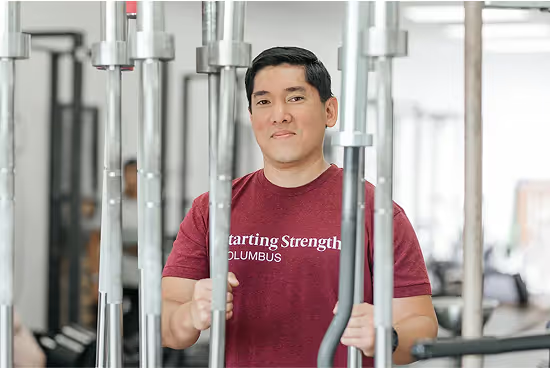If you’ve been training for a while, you already know that small aches and tight spots come with the territory. The challenge isn’t avoiding them altogether — it’s learning how to manage them so you can keep doing what you love.
At Starting Strength Columbus, we teach a principle that’s simple but powerful: movement is medicine, and strength is the prescription.
As Dr. Jonathon Sullivan describes in the original article “Everyday Pain Management for the Athlete of Aging”, pain doesn’t have to mean you stop training. With the right approach, it can become an opportunity to rebuild stronger and smarter.
1. Pain Doesn’t Always Mean Stop
The first thing to understand is that pain and damage are not the same thing.
A little soreness or stiffness is often part of the body’s normal response to hard work. The key is to pay attention — not panic.
When something feels off, our coaches help you identify whether it’s normal training fatigue or something that needs modification.
In most cases, movement done correctly and consistently actually helps discomfort fade, while inactivity makes it worse.
Training teaches your body to adapt. Avoiding movement teaches it to weaken.
2. Strength Is the Ultimate Preventive Medicine
Lifting improves far more than your muscles.
It strengthens connective tissue, improves circulation, enhances posture, and stabilizes joints.
When you get stronger, the small imbalances and weaknesses that cause nagging pain begin to disappear.
Over time, your body learns to move more efficiently, reducing stress on joints and restoring confidence in motion.
At Starting Strength Columbus, we don’t train through pain — we train past it by teaching proper form, progressive loading, and consistency.
3. Recovery Is the Real Secret Weapon
As your training age increases, recovery becomes just as important as the lifts themselves.
That doesn’t mean doing less — it means recovering better.
Sleep, nutrition, and mobility all play critical roles in how your body adapts to stress.
Our coaches help you fine-tune these elements so you can keep making progress while staying healthy and energized.
Small changes in your habits can add up to big differences in how you feel day to day.
4. Train for the Long Game
Being strong in your 40s, 50s, and beyond isn’t about chasing records — it’s about staying capable, independent, and pain-free for the long haul.
Training smart means understanding how to adjust intensity, volume, and recovery without losing progress.
That’s where structured coaching makes all the difference.
We’ll help you adapt your program so it supports your goals and lifestyle, ensuring that every session moves you forward without unnecessary setbacks.
Move Well. Feel Better. Stay Strong.
You don’t have to train through pain, and you don’t have to slow down.
You just need a smarter plan and a coach who knows how to guide you through it.
👉 Book your free 30-minute coaching session here.




